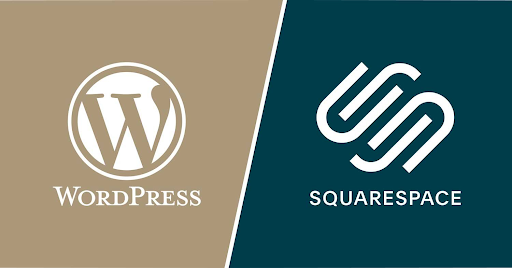WordPress VS. Squarespace - Best CMS for your Business (2024)

What is a CMS?
A CMS (Content Management System) is software that enables users to create, manage, and modify content on a website without needing specialized technical knowledge. It provides an interface to handle tasks like uploading content, editing text, and managing multimedia files, simplifying website maintenance. CMS platforms often come with templates, plugins, and tools that allow for customization and functionality enhancements. Popular CMS examples include WordPress, Squarespace, and Drupal. These systems are commonly used for blogs, e-commerce sites, and corporate websites, making web management accessible to non-developers.
WordPress VS Squarespace
Two of the most popular CMSs are WordPress and Squarespace. In this article we would compare both in detail so it becomes easier to understand which is better for use.
WordPress
WordPress is the world’s most popular CMS, powering over 40% of all websites. It is an open-source platform, which means it’s free to use, and developers worldwide contribute to its ongoing development. WordPress offers unparalleled flexibility and customization, making it suitable for everything from simple blogs to complex e-commerce sites.
Squarespace
Squarespace, on the other hand, is a fully hosted website builder. It is a closed-source platform, meaning the code is proprietary, and users cannot modify the underlying code. Squarespace is known for its sleek design templates and all-in-one functionality, which makes it a popular choice for small businesses, artists, and creatives looking for a professional online presence with minimal effort.
Features and Functionality
WordPress: WordPress is renowned for its flexibility and extensibility. It offers an immense range of features and functionalities through its vast library of plugins and themes:
- Themes: WordPress offers thousands of free and premium themes, enabling users to choose a design that fits their specific needs. The themes vary greatly in design, functionality, and customization options.
- Plugins: With over 58,000 plugins available in the WordPress repository, users can extend their website’s functionality to include almost anything—SEO tools, social media integration, e-commerce, analytics, and more.
- Customization: WordPress allows users to access and modify the site’s underlying code (HTML, CSS, PHP), making it highly customizable. This is ideal for developers or users with coding knowledge who want complete control over their site’s appearance and functionality.
- Content Management: WordPress’s content management system is robust, featuring a powerful editor, custom post types, and advanced media management tools. It’s particularly well-suited for content-heavy websites like blogs, news sites, and educational portals.
- WordPress hosting: Due to its popularity several leading hosting providers offer managed WordPress hosting services. It is specifically designed for WordPress-based websites and offers many customizations and built-in functions too.
- E-commerce: Through plugins like WooCommerce, WordPress can be transformed into a full-fledged e-commerce platform, supporting product catalogs, multiple payment gateways, and detailed inventory management.
Squarespace: Squarespace offers an integrated, all-in-one platform with features designed to simplify the website-building process:
- Templates: Squarespace provides a curated selection of professionally designed templates. These templates are fully responsive, meaning they are optimized for all devices, and are designed to showcase visual content effectively.
- Built-in Features: Squarespace comes with built-in features that cover a wide range of needs, such as blogging tools, e-commerce capabilities, analytics, and email marketing. This reduces the need for third-party integrations.
- Customization: Squarespace offers a style editor that allows users to customize colors, fonts, and layouts without needing to code. While less flexible than WordPress, it is easier for non-technical users to navigate.
- Content Management: Squarespace’s editor is highly intuitive, featuring drag-and-drop functionality and inline editing. It is designed to make content creation and management straightforward and user-friendly.
- E-commerce: Squarespace’s e-commerce capabilities are integrated into the platform, making it easy to set up and manage an online store. While it’s not as flexible as WooCommerce on WordPress, it covers the needs of most small to medium-sized businesses.
Ease of Use
WordPress: WordPress is a powerful platform, but it comes with a steeper learning curve, especially for beginners:
- Setup: Setting up a WordPress site involves several steps: purchasing a domain, selecting a hosting provider, installing WordPress, choosing a theme, and configuring plugins. While some hosting providers offer one-click installations, there’s still a fair amount of initial setup required.
- Customization: While WordPress offers unrivaled customization options, these often require some familiarity with coding or hiring a developer. The flexibility can be overwhelming for beginners, and making changes to a theme or adding custom functionality can be complex.
- Maintenance: WordPress sites require regular maintenance, including updates to the core software, themes, and plugins. Users are also responsible for site security, backups, and performance optimization, which can be challenging for those without technical expertise.
- Squarespace: Squarespace is designed with ease of use in mind, making it accessible to users of all skill levels:
- Setup: Squarespace’s setup process is straightforward and user-friendly. Once you sign up, you can choose a template and start customizing it immediately. All the technical aspects, including hosting and security, are handled by Squarespace, so there’s no need to worry about configuring servers or installing software.
- Customization: Squarespace’s drag-and-drop editor and style customization tools are intuitive, allowing users to create a visually appealing site without needing to code. The platform’s design options are more limited compared to WordPress, but they are easier to use and understand.
- Maintenance: Squarespace handles all technical maintenance, including software updates, security, and backups. This hands-off approach allows users to focus on content creation and running their business without worrying about the underlying technology.
Design and Customization
WordPress: WordPress is highly customizable, making it ideal for users who want full control over their site’s design:
- Themes: WordPress offers thousands of themes, ranging from simple blog templates to complex e-commerce designs. Themes can be customized through the WordPress Customizer or by editing the underlying code, providing limitless possibilities for design.
- Customization: WordPress’s customization capabilities are virtually unlimited. Users can add custom CSS, modify theme files, and use page builders like Elementor or Divi to create unique layouts. This level of customization is perfect for developers or those with a specific vision for their site.
- Page Builders: WordPress supports a variety of page builder plugins that allow users to create custom layouts with drag-and-drop functionality. These tools provide more flexibility than Squarespace’s built-in editor, though they may require more time to master.
Squarespace: Squarespace is known for its sleek, modern design templates that are easy to customize:
- Templates: Squarespace offers a selection of professionally designed templates that are known for their aesthetic appeal. These templates are fully responsive and optimized for a range of devices, ensuring that your site looks good on mobile, tablet, and desktop screens.
- Customization: While Squarespace’s customization options are more limited than WordPress, its style editor allows users to make significant design changes without coding. Users can adjust colors, fonts, and layout elements directly through the interface.
- Consistency: Squarespace’s templates are designed to ensure a consistent and polished look across all pages. This can be a limitation if you want a highly unique design, but it’s an advantage if you prefer a cohesive and professional appearance with minimal effort.
E-commerce Capabilities
- WordPress: WordPress is a powerful platform for building e-commerce sites, particularly with the WooCommerce plugin:
- WooCommerce: WooCommerce is a flexible, open-source e-commerce plugin that can be used to sell products, manage inventory, process payments, and more. It is highly customizable, with a large ecosystem of extensions and themes specifically designed for e-commerce.
- Scalability: WordPress with WooCommerce is suitable for online stores of all sizes, from small shops to large enterprises. It supports complex product catalogs, multiple payment gateways, shipping options, and integrations with various third-party services.
- Customization: With WordPress, you can customize every aspect of your online store, from the product pages to the checkout process. This level of control is ideal for businesses with specific e-commerce needs or those that want to create a unique shopping experience.
Squarespace: Squarespace provides built-in e-commerce functionality that is easy to set up and use:
- Integrated E-commerce: Squarespace’s e-commerce tools are built into the platform, making it simple to create a store, add products, and start selling. The platform supports physical and digital products, services, and even subscription-based offerings.
- Ease of Use: Squarespace’s e-commerce features are designed to be user-friendly, with a guided setup process and a straightforward interface for managing products, orders, and customers.
- Limitations: While Squarespace’s e-commerce capabilities are sufficient for most small to medium-sized stores, they are less flexible than WooCommerce. Customization options are more limited, and some advanced features (like certain payment gateways or shipping)
When creating a website, choosing the right content management system (CMS) is crucial. Both WordPress and Squarespace platforms are well-known and widely used, but they serve different purposes and cater to distinct types of users. In this detailed comparison, we have explored various aspects such as pricing, features, functionality, ease of use, design and customization, e-commerce capabilities, SEO tools, support, and scalability to help you decide which platform is better suited for your needs.
Note: IndiBlogHub features both user-submitted and editorial content. We do not verify third-party contributions. Read our Disclaimer and Privacy Policyfor details.







